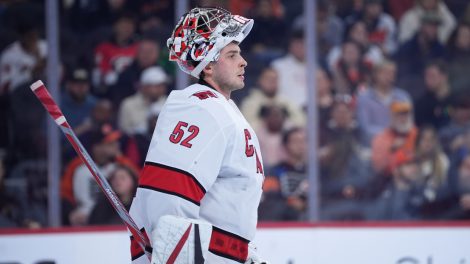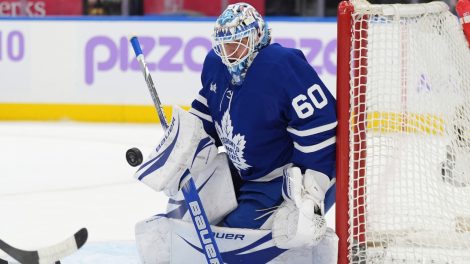The grand experiment that is the goal-happy, puck-possessing Toronto Maple Leafs — as cast in GM Kyle Dubas’s design and operated by his flexible, handpicked head coach Sheldon Keefe — faces the double-sided exam of first rallying to make the playoffs and then winning a round for the first time in 16 tortuous springs.
The year 2020 brings clarity to the Dubas vision. Now we’ll start to find out if, when roster-maker and lineup-maker are on the same page, this thing can hum.
That, of course, will be the overarching storyline to the year. But there are subplots at play that make for intriguing discussion. Here, from the net out, are three major narratives that will shape the Leafs in 2020.
[snippet id=4167285]
Is it safe to overwork a workhorse?
As much as Michael Hutchinson’s first win of the season served good reason to exhale — for the goaltender, the organization and the fan base chanting his name — the Maple Leafs have only earned five standings points from the backup goaltending position in three months.
While it is hockey cliché to worry about a team’s fortunes if the starting goaltender goes down to injury, nowhere is that more true than in Toronto, where Dubas has elected to save money on goaltending depth and, likely, knocks wood every time Frederik Andersen takes the crease and adds to his league-leading tally of shots faced since Lou Lamoriello acquired him back in 2016.
Can Hutchinson, now approaching his job with a joy and mental clarity that eluded him in October and November, dig in and perform at a better-than-.500 clip the rest of the winter? Can Hutch’s performance earn enough trust — or, more accurately, can the Leafs amass enough standings points — to curb Andersen’s workload and put some of the team MVP’s rested performances on ice for the post-season?
In the meantime, Keefe and the Leafs’ crack squad of sports scientists are trying to ease Andersen’s burden by pushing shots to the perimeter and taking it easy in practice.
It’s quite the conundrum: The lopsided reliance on Andersen rails against recent wisdom that regular-season tandems set the stage for deep playoffs runs (see: Pittsburgh, Washington, St. Louis, Boston, Chicago), yet Keefe might need to ride his great Dane just to qualify.
“Generally,” Keefe says, “you just want to have your best guy in [net] as often as you can.”
Watch for trade bait at the wings
For three months we’ve been whispering about the Maple Leafs’ impending roster crunch and how their salary-cap headaches will force a depth forward on waivers. Yet “timely” injuries keep postponing hard decisions.
Jake Muzzin (foot) and Ilya Mikheyev (wrist) join Trevor Moore (concussion) and Andreas Johnsson (leg) as the latest to crowd up sick bay. The emergence of rookie call-up Pierre Engvall — a deft penalty-killer with a long stick and the trust of his coach — only complicates the logjam.
When – or if – Toronto’s forward corps returns to health, does Dubas risk losing Timashov or Gauthier on waivers? We can’t see him demoting Engvall, who’s proving dependable in a top-nine role.
With more intriguing forward prospects knocking on the door (Jeremy Bracco and Adam Brooks have each been granted call-ups) and cheap depth in the AHL (Pontus Aberg, Egor Koshkov, Kenny Agostino), the Leafs certainly have bottom-six forwards they could trade.
Depending on the toll Muzzin’s absence takes, Dubas may be compelled to add blue line depth.
Hey, there is inexpensive talent eager for minutes should the Leafs elect to trade a player with term, knowing full well that Mikheyev, Engvall, Gauthier and Timashov could be due raises into the seven figures this summer.
Dubas has received tire-kicking calls on speedy Kasperi Kapanen, who has yet to find a proper niche in Keefe’s lineup.
“I don’t have that answer here yet. We’re still looking at that,” Keefe said. “All season he’s been moving around and hasn’t found any traction there. We want to be patient with him. I watch his game, and you still see a lot of good things that he’s doing. It’s just not resulting in a lot of things happening around the net.”
Yes, the Leafs will work to make all their wingers fit, but if not… there are options.
Wanted: Defencemen who will play for food
The challenge of hosting a rich reserve of capable moving parts up front and investing an NHL-high $54.9 million worth of cap space in forwards is plugging holes on the blue line.
Morgan Rielly is the only member of the defence signed beyond June 30, and there simply won’t be enough coin to keep pending free agents Tyson Barrie, Jake Muzzin, Cody Ceci, Justin Holl and Travis Dermott happy.
Even if you assume first-round draft picks Rasmus Sandin and Timothy Liljegren become full-time NHLers next fall (which we do), and even if you bank on Holl and Dermott getting the type of pay bumps that don’t break the bank (ditto), there is still ice time that needs filling.
How — and how effectively — Dubas chooses to address his greatest need on a budget will be a fascinating narrative of 2020, one exacerbated by Muzzin’s fractured foot.
Can he really convince Muzzin or Barrie to hang around when it’s their last, best shot at a juicy payday?
Does a need for defensive balance put a middle-class soldier like Kapanen or Johnsson in trade danger, the way it did for Nazem Kadri in 2019?
Does Dubas satisfy the hounds and go for the nuclear option of trading 33-goal-pace William Nylander ($6.96 million cap hit) to free up the space required to chase a big fish like Alex Pietrangelo?
Or do the offence-first Leafs trust in 5-4 hockey and patch holes with the next coming of Igor Ozhiganov?
Regardless, the composition of the Toronto Maple Leafs’ blue line will feed the Nation’s bottomless hunger for barroom, chatroom and studio room debate.
[relatedlinks]








